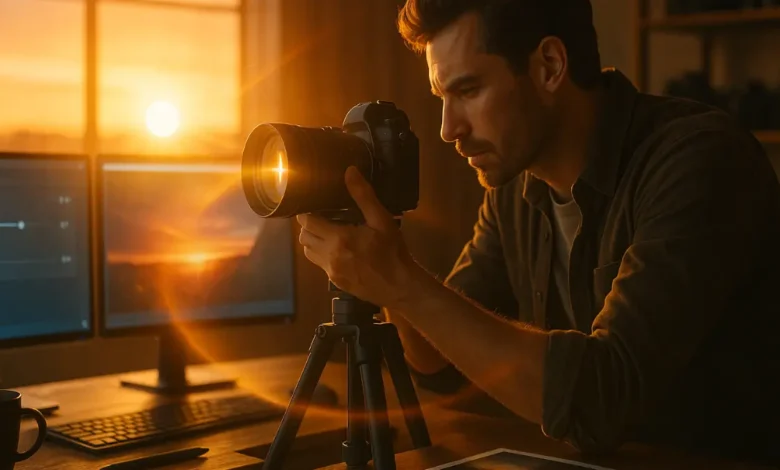Mastering the Glow: The Art and Precision of Photeeq Lens Flare in Modern Photography

Enhance your photos with the Photeeq lens flare effect — learn expert tips to create cinematic light, mood, and realism for your images with precision and creativity.
In the world of photo editing and digital art, few effects bring as much cinematic drama as the photeeq lens flare. It’s the subtle burst of light that transforms an ordinary picture into something emotionally charged, visually warm, and atmospheric. With the Photeeq tool, this once-accidental effect becomes an intentional part of your creative process.
When you use the photeeq lens flare, you’re not just adding light — you’re shaping mood. A flare can make a sunset look more romantic, a portrait feel warmer, or a street scene come alive with authenticity. The power of the Photeeq tool lies in its ability to give you that film-like quality without relying on perfect outdoor conditions.
What Is Photeeq Lens Flare
The photeeq lens flare simulates the real-world effect that occurs when bright light directly enters the camera lens. Traditionally, lens flares happened unintentionally — sunlight hitting the lens glass, reflections bouncing through optical elements, creating streaks, rings, or haze. What Photeeq does is allow you to reproduce and control that phenomenon digitally.
Unlike random in-camera flares, Photeeq offers total control. You decide the flare’s position, strength, color, and diffusion. It transforms something unpredictable into a professional lighting technique. The photeeq lens flare plugin or effect helps editors mimic the look of expensive cinematography, making still photos and digital compositions glow with storytelling depth.
The Art of Light and Emotion
The beauty of photeeq lens flare isn’t just technical — it’s emotional. Light carries meaning. A soft flare can evoke nostalgia or warmth; a sharp streak can suggest intensity or speed. By mastering how to use photeeq lens flare, photographers and designers turn static visuals into living stories.
When you overlay a controlled flare, it guides the viewer’s eye naturally. It adds dimensionality, directing attention toward your subject while filling the frame with atmosphere. That’s why film posters, music videos, and commercial photography often feature flares — they make a scene feel. Photeeq brings that cinematic storytelling into your digital toolbox.
How to Use Photeeq Lens Flare Effectively
Learning how to handle photeeq lens flare is about balance. Too much, and your image feels overdone. Too little, and the effect is lost. The goal is to integrate the flare so it feels natural, like it truly belonged in the captured moment.
Start by choosing a light source within the image — the sun, a lamp, or a reflective surface. Align your flare with it using Photeeq’s intuitive controls. Adjust brightness and spread carefully; lower intensity often feels more authentic. Experiment with warm and cool tones — a golden flare enhances sunsets, while a cooler blue fits urban or night imagery.
Photeeq allows layer adjustments, so you can apply the effect selectively. Mask areas where flare shouldn’t appear, and feather edges for a seamless blend. The best photeeq lens flare images look like they were shot that way naturally, even though they were crafted in post.
Common Mistakes and How to Avoid Them
Even seasoned editors can misuse the photeeq lens flare effect. One of the most common errors is overexposure — pushing the flare’s brightness too far until it washes out key details. Remember, the purpose is to enhance, not dominate.
Another issue is improper placement. A flare that doesn’t align with a realistic light source feels fake. Always ensure that shadows, highlights, and reflections agree with where you place the flare. Lastly, avoid using identical flare settings on every photo — the photeeq lens flare should adapt to the unique lighting and emotion of each image.
Creative Ways to Apply Photeeq Lens Flare
The photeeq lens flare is not just for sunsets or landscapes — it’s incredibly versatile. You can use it in portraits to soften harsh light, in architecture shots to give a polished glow, or in digital artwork to emphasize movement and depth.
Try combining multiple flares for layered lighting — for example, one subtle primary flare near the horizon and a secondary small glint to simulate lens reflection. Photeeq makes this possible through its multi-layer control, letting you fine-tune angles, radius, and opacity.
Fashion editors often use photeeq lens flare to add warmth to editorial shoots, while filmmakers apply it to simulate cinematic lighting. The tool becomes an extension of artistic vision — not just an effect, but a language of light.
Technical Control and Precision
Behind its simplicity, the photeeq lens flare is powered by precise optics simulation. It mimics real-world lens behavior, calculating how light interacts with glass elements and internal reflections. For photographers who understand exposure and contrast, this means you can replicate real physics in a creative digital space.
Use the intensity slider to manage how strong the reflection appears, and the bloom control to adjust the halo’s diffusion. You can even manipulate color temperature to match your photo’s overall tone. The Photeeq interface makes experimentation intuitive — and once you find your preferred style, it’s easy to apply consistently across projects.
Building Cinematic Visuals with Photeeq
If you’ve ever admired the golden glow of a movie scene or the soft haze of a music video frame, that’s the cinematic look photeeq lens flare helps you achieve. Adding controlled light artifacts creates depth, emotion, and realism.
Think of your photo as a movie still. Where is the source of light? What emotion do you want to evoke — calm, warmth, tension? Then place your photeeq lens flare accordingly. Use it to tell a story rather than just decorate the image. The more intentional your use, the more authentic and striking your result.
Table: Photeeq Lens Flare Quick Guide
| Setting | Function | Best Used For |
|---|---|---|
| Position | Moves flare across frame | Align with visible light sources |
| Intensity | Adjusts brightness | Enhancing realism or mood |
| Color Temperature | Warms or cools tone | Matching environment lighting |
| Bloom | Expands glow | Creating soft, dreamy look |
| Masking | Limits effect area | Keeping subject sharp |
| Opacity | Controls visibility | Blending into scene naturally |
Expert Tips for Realistic Results
An expert’s secret when using photeeq lens flare is subtlety. The human eye naturally expects light to diffuse softly and fade out. To make your flares believable, always start with lower opacity and gradually increase until it complements the image.
Match your flare’s hue with the scene’s dominant light source. A golden flare on a cool-toned photo feels inconsistent; instead, adapt it to the palette. Also, consider direction — flares should generally follow the same angle as shadows or highlights already present.
Inspirational Quote
“A single ray of light can change the tone of an entire image. The Photeeq lens flare is that ray — controlled, artistic, and full of emotion.”
Why Photeeq Lens Flare Stands Out
Among other editing tools, photeeq lens flare stands out for its realism and control. Unlike generic overlays or stock flares, it allows dynamic adjustment that responds to your composition. You can fine-tune reflection patterns, simulate lens glass types, and even replicate camera brands for specific flare behavior.
That level of customization means whether you’re editing travel photography, cinematic stills, or brand campaigns, you can maintain both consistency and individuality. The end result feels handcrafted rather than automated.
The Psychology of Light in Visuals
Light has deep psychological influence. When you use photeeq lens flare, you’re not just editing pixels — you’re evoking feeling. A soft, diffused flare induces calmness and intimacy. A sharp, streaking flare energizes the frame, creating excitement or motion.
Understanding this psychology helps you decide when to apply the effect. In lifestyle imagery, subtle warm flares suggest happiness or nostalgia. In product photos, clean directional flares add professionalism and focus. The photeeq lens flare bridges emotional storytelling with visual design.
Maintaining Authenticity in Digital Editing
While the photeeq lens flare offers powerful creative potential, authenticity is key. Viewers today are savvy; they can spot over-editing quickly. The best approach is to make your flares so integrated they feel invisible — part of the natural light.
Use gradient masking and careful exposure balancing. Let the flare enhance depth and color without overpowering. When used tastefully, photeeq lens flare can turn ordinary scenes into believable, emotionally resonant visuals.
FAQs
What is Photeeq lens flare used for?
It’s used to recreate realistic light reflections and glows in photography or digital art, adding cinematic mood and depth to visuals.
Can beginners use Photeeq lens flare easily?
Yes. Its interface is intuitive and designed for both beginners and professionals. Simple sliders and previews make it easy to experiment.
Does lens flare make photos look unrealistic?
Only when overused. A well-placed photeeq lens flare looks natural, especially when aligned with existing light sources.
Can I use Photeeq lens flare for videos?
Yes. Photeeq tools integrate with visual editing suites and motion graphics software, allowing dynamic flare movement across frames.
What makes Photeeq lens flare different from other flare tools?
It uses optical simulations and customizable parameters for realism, giving precise control over light behavior and artistic impact.
Conclusion
The photeeq lens flare is more than an effect — it’s a storytelling tool. When mastered, it transforms lighting into language, guiding emotion and focus with precision. Whether you’re enhancing portraits, landscapes, or digital art, Photeeq gives you control over one of photography’s most magical elements: light.
Used wisely, it bridges realism and creativity, turning ordinary photos into cinematic experiences that captivate the eye and stir the imagination.





